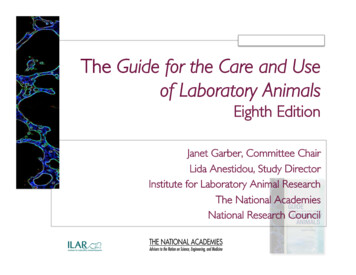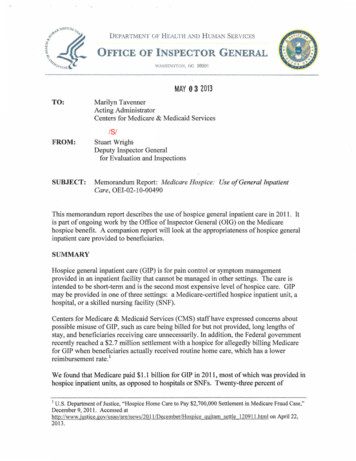
Transcription
The Guide for the Care and Useof Laboratory Animals Eighth EditionJanet Garber, Committee ChairLida Anestidou, Study DirectorInstitute for Laboratory Animal ResearchThe National AcademiesNational Research Council
The National Academies Chartered by Congress in1863 at the request ofPresident Lincoln to advise the nation 3 Honorary Societies National Academy of Sciences - 1863 National Academy of Engineering - 1964 Institute of Medicine - 1970 And an operating arm National Research Council - 1916
The National Academies are Independent and objective Non-profit (no compensation beyond actual expenses;also have endowment funds) Able to draw on leading experts from scientific andtechnical disciplines 55% academia 24% industry 12% government 9% non-profit
Study process (FACA section 15)Statement of TaskCoI/balance andexpertise
Statement of Task A committee will update the 1996 version of the Guide for the Careand Use of Laboratory Anima1s (the Guide) to reflect new scientificinformation related to the issues already covered in the Guide, andto add discussion and guidance on new topics of laboratory animalcare and use related to contemporary animal research programs. The committee will review the scientific literature published sincethe release of the 1996 Guide and determine whether theinformation in the Guide concurs with current scientific evidence.The committee will also review the literature on new technologiesrelated to laboratory animal care and use and determine where newguidance is necessary to ensure the best scientific outcomes andoptimal animal welfare.
Statement of Task (cont.) The committee will also take into consideration all materials anddiscussions provided to it, including those submitted to NIH in responseto the Request for Information NOT -OD-O6-011 that requestedinformation related to the need to update the Guide. Wherescientifically warranted, the guidance and recommendations of the 1996Guide will be changed to reflect new scientific evidence, whilemaintaining the performance standards of the 1996 Guide. Thecommittee will ensure that any recommendations in the Guide will beconsistent with current Public Health Service Policy, the Animal WelfareRegulations, and the most recent Report of the American VeterinaryMedical Association Panel on Euthanasia. In addition to the published report, the updated Guide will be postedon the Internet in a pdf or equivalent format such that users will be ableto search the entire document at one time.
Preface Formal process to regularly revisit the scientificinformation & practice standards is needed Areas with insufficient data and assessment -further study is needed Space and housing needs Enrichment, exercise and human contact
Overview The Committee explains the reasons for (not) updating/expanding certain sections of the Guide Commitment to the Three Rs Animal Care and Use Program Aquatic species Recommended minimum space and space recommendations Social housing for nonhuman primates Rodent female litter category
In the 8th edition of the Guide What has changed? What hasn’t changed?
Performance Standards Remains a key concept in application of theGuide Overwhelming support for this approach Better definition of desired outcomes More guidance on how to achieve theoutcomes
Animal Care and Use Program ’96 Guide lacked clarity regarding this importantconcept. Those activities conducted by and at an institutionwhich have a direct impact on the well-being ofanimals including policies and procedures, theprovision of animal and veterinary care, personneland program management and oversight,occupational health and safety, IACUC functions,and animal facility design and management.
What Looks Different?Chapters 1 & 2Previously: “Introduction” Chapter 1 – “Institutional Policies and Responsibilities”Now: Chapter 1 – “Key Concepts” Chapter 2 – “Program of Animal Care and Use”
What Looks the Same?Chapters 3, 4 and 5Previously: Chapters 2, 3 & 4Now: Chapter 3 – “Animal Environment, Housing andManagement” Chapter 4 – “Veterinary Care” Chapter 5 – “Physical Plant”
New & Expanded Topics: Chapters 1 & 2 Ethics of Animal Use & the Three R’s Responsibilities of Key Personnel (IO, AV, IACUC) Institutional Collaborations Training and Education Program Oversight IACUC PAM Special Considerations for Protocol Review Disaster Planning and Emergency Preparedness
New & Expanded Topics: Chapter 3 Terrestrial & Aquatic Animals HVAC Vibration Environmental Enrichment Housing & Space Recommendations Procedural Habituation & Training of Animals
New & Expanded Topics: Chapter 4 Transportation of Animals Preventive Medicine – Animal Biosecurity Clinical Care & Management Medical Management Emergency Care Recordkeeping Surgery – Intraoperative Monitoring
New & Expanded Topics: Chapter 5 Centralization vs. Decentralization HVAC Vibration Control Environmental Monitoring Special Facilities Security & Access Control
Chapter 1: Key Terms used in the Guide Humane Care Animal Care and Use Program Engineering and Performance Standards Practice Standards Policies, Principles and Procedures Must, Should and May
Chapter 1: Practice Standards“The application of professional judgment to a task orprocess over time, which has been demonstratedto benefit or enhance animal care and use.” Key concept expressed in comments to the CommitteeInformation in peer-reviewed literatureTime-proven experience in the fieldModification of practices and procedures with changingconditions and new information
Chapter 1:“Must” and “Should” “Must” - The verb “must” indicates actions that theCommittee to Update the Guide consider to beimperative and are a mandatory duty orrequirement. “Should” - The verb “should” indicates a strongrecommendation for achieving a goal, however,the committee recognizes that individualcircumstances might justify an alternative strategy.
Examples of “must” Veterinary Care & Animal Well-Being “The institution must develop methods for reportingand investigating animal welfare concerns.” (Chapter2 – New section added on reporting concerns). “Antinociception occurs at a surgical plane ofanesthesia, and prior to surgery, adequateantinociception must be ascertained.” (Chapter 4 –Expansion of section on Anesthesia & Analgesia,based on NRC 2009 Pain Report).
Examples of “must” Regulatory Requirement “When applicable, request must be made to theUSDA, APHIS by the IO to seek an exemption tolimiting regulated animals from being used in onlyone animal use protocol with a major survivalsurgical procedure (CFR 1985; USDA-APHIS1997).” (Chapter 2 – added per new USDArequirement).
Examples of “must” Safety “Rooms with MR scanners or in which cryogen isstored must be equipped with oxygen sensors anda method for increasing room ventilation toexhaust inert gases during cryogenfilling.” (Chapter 5 – New section on imagingfacilities).
Examples of “must” Clarification “The IACUC (or institutional equivalent) isresponsible for assessment and oversight of theinstitution’s Program components andfacilities.” (Chapter 2 – clarification ofresponsibilities)
Chapter 2: Special Considerations for Protocol Review Experimental and Humane Endpoints Unintended Consequences Physical Restraint Multiple Survival Surgical Procedures Food and Fluid Regulation Use of Non-Pharmaceutical Grade Chemicals and otherSubstances Field Investigations Agricultural Animals
Chapter 2: Post-Approval Monitoring PAM in the broadest sense: All potential types of monitoring – continuing review Inspections (internal and external) Medical surveillance Observations by animal users and care staff Formality and intensity depends on the size andcomplexity of the Program
Chapter 2: Disaster Planning & Emergency Preparedness“Facilities must have a disaster plan.” Prevent animal pain, distress and deaths Potential loss of ventilation, cooling, heating orwater Triage Trained personnel
Chapter 3: Terrestrial & Aquatic Animals Water Quality (composition of the water) Temperature pH & Alkalinity Nitrogen Waste Products Conductivity/salinity Hardness Dissolved oxygen Life Support System (LSS) Physical structure used to contain the water and animals Equipment used to move and /or treat the water
Chapter 3: Housing Environment Noise & Vibration Temperature & Humidity Thermoneutral Zone (TNZ) Lower Critical Temperature (LCT) Resources for thermoregulation (e.g., nesting materials) Ventilation & Air Quality Individually Ventilated Cage (IVC) Systems Variable Air Volume (VAV) Systems
Chapter 3: Environmental Enrichment Expanded section Stresses social housing for social animals Not all enrichment is beneficial Enrichment is an independent variable and shouldbe appropriately controlled Nesting material is discussed as a component ofbedding
Chapter 3: Space Recommendations Expanded discussion of considerations for housing– performance standards Stresses pair/group housing Tables include specific comments Few changes in the recommendations
Chapter 3: Space Recommendations (cont.) Rats & Mice – Recommended space for female litter Rabbits – cage height changed from 14” to 16” Nonhuman Primates Expanded “Monkeys” from 7 to 8 groups Separate recommendations for chimpanzees
Chapter 4: Veterinary Care Transportation – Expanded Intra- and inter-institutional transport Biosecurity during transport Animal Biosecurity (in Preventive Medicine) Clinical Care and Management Medical Management Emergency Care Recordkeeping
Chapter 4: Veterinary Care (cont.) Surgery – Expanded Training Surgical Procedures – Major vs. Minor Intraoperative Monitoring
Chapter 5: Physical Plant HVAC IVCs VAV Systems (vs. constant volume systems) Pressurization Vibration Control Environmental Monitoring Security and Access Control
Chapter 5: Specialized Facilities Surgery Imaging Barrier Facilities Whole Body Irradiation Behavioral Studies Aquatic Species Housing
Chapter 3: Space Recommendations – Nonhuman Primates 1Monkeys: Group 1: Up to 1.5 kg – 2.1 sf/30” h Group 5: Up to 20 kg – 8 sf/36” h Group 6: Up to 25 kg – 10 sf/46” h Group 7: Up to 30 kg – 15 sf/46” h Group 8: 30 kg – 25 sf/60” h
Chapter 3: Space Recommendations – Nonhuman Primates IIChimpanzees: Juveniles: Up to 10 kg – 15 sf/60” h Adults: 10 kg - 25 sf/84” h
the release of the 1996 Guide and determine whether the information in the Guide concurs with current scientific evidence. The committee will also review the literature on new technologies related to laboratory animal care and use and determine where new guidance is necessary to ensure the best scientific outcomes and optimal animal welfare. !











